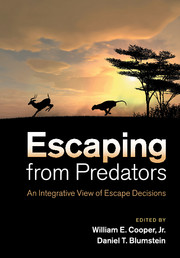Crossref Citations
This Book has been
cited by the following publications. This list is generated based on data provided by Crossref.
Møller, Anders Pape
Samia, Diogo S. M.
Weston, Mike A.
Guay, Patrick-Jean
Blumstein, Daniel T.
and
Moreira, Francisco
2014.
American Exceptionalism: Population Trends and Flight Initiation Distances in Birds from Three Continents.
PLoS ONE,
Vol. 9,
Issue. 9,
p.
e107883.
Møller, A. P.
2014.
Life history, predation and flight initiation distance in a migratory bird.
Journal of Evolutionary Biology,
Vol. 27,
Issue. 6,
p.
1105.
Møller, Anders Pape
and
Nielsen, Jan Tøttrup
2014.
Parental defense of offspring and life history of a long-lived raptor.
Behavioral Ecology,
Vol. 25,
Issue. 6,
p.
1505.
Cooper, William E.
and
Sherbrooke, Wade C.
2015.
Averted predator gaze reduces latency to flee by zebra-tailed lizards (Callisaurus draconoides).
Animal Biology,
Vol. 65,
Issue. 3-4,
p.
299.
Samia, Diogo S. M.
Pape Møller, Anders
and
Blumstein, Daniel T.
2015.
Brain size as a driver of avian escape strategy.
Scientific Reports,
Vol. 5,
Issue. 1,
Møller, Anders Pape
Díaz, Mario
Flensted-Jensen, Einar
Grim, Tomas
Ibáñez-Álamo, Juan Diego
Jokimäki, Jukka
Mänd, Raivo
Markó, Gábor
and
Tryjanowski, Piotr
2015.
Urbanized birds have superior establishment success in novel environments.
Oecologia,
Vol. 178,
Issue. 3,
p.
943.
Samia, Diogo S. M.
Blumstein, Daniel T.
and
Hemmi, Jan M
2015.
Birds Flush Early and Avoid the Rush: An Interspecific Study.
PLOS ONE,
Vol. 10,
Issue. 3,
p.
e0119906.
Bateman, P. W.
and
Fleming, P. A.
2015.
Escape behaviour in shore crabs: constraints of body size and available shelter.
Journal of Zoology,
Vol. 297,
Issue. 4,
p.
265.
Samia, Diogo S. M.
Nakagawa, Shinichi
Nomura, Fausto
Rangel, Thiago F.
and
Blumstein, Daniel T.
2015.
Increased tolerance to humans among disturbed wildlife.
Nature Communications,
Vol. 6,
Issue. 1,
Juška, Alfonsas
2015.
Analysis of biological processes.
p.
149.
Gvoždík, Lumír
and
Smolinský, Radovan
2015.
Body size, swimming speed, or thermal sensitivity? Predator-imposed selection on amphibian larvae.
BMC Evolutionary Biology,
Vol. 15,
Issue. 1,
Gal, Shmuel
Alpern, Steve
and
Casas, Jérôme
2015.
Prey should hide more randomly when a predator attacks more persistently.
Journal of The Royal Society Interface,
Vol. 12,
Issue. 113,
p.
20150861.
Blumstein, Daniel T.
Flores, Guadalupe
Munoz, Nicole E.
and
Ebensperger, L.
2015.
Does Locomotor Ability Influence Flight Initiation Distance in Yellow-Bellied Marmots?.
Ethology,
Vol. 121,
Issue. 5,
p.
434.
Obleser, Petr
Hart, Vlastimil
Malkemper, E. Pascal
Begall, Sabine
Holá, Michaela
Painter, Michael S.
Červený, Jaroslav
and
Burda, Hynek
2016.
Compass-controlled escape behavior in roe deer.
Behavioral Ecology and Sociobiology,
Vol. 70,
Issue. 8,
p.
1345.
Sah, Pratha
Nussear, Kenneth E.
Esque, Todd C.
Aiello, Christina M.
Hudson, Peter J.
and
Bansal, Shweta
2016.
Inferring social structure and its drivers from refuge use in the desert tortoise, a relatively solitary species.
Behavioral Ecology and Sociobiology,
Vol. 70,
Issue. 8,
p.
1277.
Ghosh, Satadal
Davis, Duane T.
and
Chung, Timothy H.
2016.
A guidance law for avoiding specific approach angles against maneuvering targets.
p.
4142.
Cooper, William E.
Sherbrooke, Wade C.
and
Ebensperger, L.
2016.
Strategic Escape Direction: Orientation, Turning, and Escape Trajectories of Zebra‐Tailed Lizards (Callisaurus draconoides).
Ethology,
Vol. 122,
Issue. 7,
p.
542.
Cooper, William E.
and
Martín, José
2016.
Predator–prey distance and latency to flee from an immobile predator: functional relationship and importance.
Current Zoology,
Vol. 62,
Issue. 2,
p.
117.
May, Tegan M.
Page, Manda J.
and
Fleming, Patricia A.
2016.
Predicting survivors: animal temperament and translocation.
Behavioral Ecology,
Vol. 27,
Issue. 4,
p.
969.
Suzuki, Toshitaka N.
2016.
Referential calls coordinate multi-species mobbing in a forest bird community.
Journal of Ethology,
Vol. 34,
Issue. 1,
p.
79.



